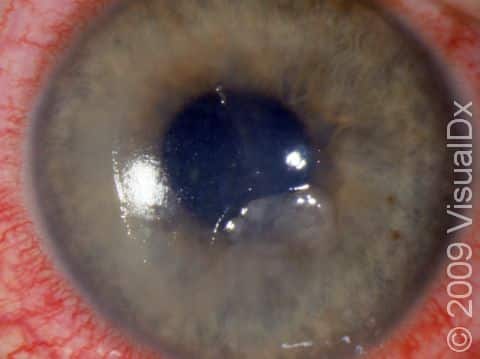Corneal Abrasion, First Aid
A corneal abrasion is a scratch or cut on the clear outer layer of the eye (the cornea). Some sort of injury or trauma is the most common cause for corneal abrasions. The most common types of injuries that cause corneal abrasions include:
- Scratches from human or animal nails / claws.
- Foreign objects coming into contact with the cornea (eg, dirt, wood splinters, metal shavings, plants, tree branches).
- Excessive rubbing of the eye.
- Overwearing of contact lenses.
- Ill-fitting contact lenses.
- Torn contact lenses.
- Makeup brushes.
- Paper cuts.
- Chemical burns.
- Irregular eyelashes rubbing the cornea or falling into the eye.
- Foreign objects that get caught under the eyelid.
Other causes include underlying eye conditions, such as:
- Inability to fully close the eyelids.
- Abnormalities of the lid position.
- Severe dry eye conditions.
- Severe, chronic blepharitis (inflamed eyelids).
Who's At Risk?
Corneal abrasions are fairly common. People who wear contact lenses or who work in dusty, dirty, windy, or debris-laden conditions are more likely to get a corneal abrasion than others.
Signs & Symptoms
Although it is very difficult to see a corneal abrasion with the naked eye, you may suspect a corneal abrasion if you experience any type of trauma to the eye and have an unrelenting painful feeling that something is in your eye that just won’t wash out. There may also be:
- Lots of watery tearing.
- Sensitivity to light (especially bright light).
- Blurry vision.
- Redness of the eye.
- Spasms of the muscles surrounding the eye, resulting in squinting.
Self-Care Guidelines
First Aid Guide
Most simple corneal abrasions will heal on their own within a day or two. While the cornea is healing, it can help to:
- Immediately remove any contact lens.
- Use saline solution, artificial tears, or clean water to bathe the eye and wash out suspected foreign matter.
- Keep the eye shut.
- Avoid rubbing the injured eye.
- Wear sunglasses to reduce light sensitivity.
Precautions that help prevent corneal abrasions include:
- Wearing protective eyewear in situations that may result in a corneal abrasion, such as working in the garden, working on grinding machines, etc.
- Being extra careful when using makeup brushes.
- Taking excellent care of and practicing excellent hygiene with contact lenses.
- Never sleeping in contact lenses, regardless of manufacturer notes.
Note: If the corneal abrasion heals and then suddenly comes back days later, this may be a sign of recurrent corneal erosion, which requires specific medical care by an ophthalmologist.
Treatments
Your medical professional will first check for any foreign objects and, if needed, clean the eye. They may provide numbing eye drops or oral pain medication during this procedure. The medical professional may prescribe antibiotic drops to reduce the risk of eye infection.
Patching is no longer recommended because it could delay healing.
If the abrasion was caused by a contact lens, you should ideally be reevaluated regarding your contact lenses as to fit and type. In the case of recurrent corneal erosion, your medical professional will begin specific treatment for that condition.
Visit Urgency
See a medical professional in the case of:
- Persistent pain beyond the first day or pain that is increasing despite self-care.
- Suspected metal, wood, plant material, or other foreign object stuck in the cornea.
- Any abrasion caused by chemicals, heat burns, makeup brushes, or plant material.
- Recurrence of pain and/or other symptoms days after an initial corneal injury.
- Pus-like discharge from the eye.
- Progressive vision loss.
Last modified on August 8th, 2024 at 4:30 pm

Not sure what to look for?
Try our new Rash and Skin Condition Finder
